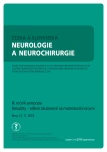Wound healing effects after application of polyunsaturated fatty acids in rat
Authors:
A. Hokynková 1; Z. Wilhelm 2; M. Nováková 2; P. Babula 2; T. Stračina 2; H. Paulová 3; M. Hlaváčová 3; M. Sedláčková 4
Authors‘ workplace:
Klinika popálenin a plastické chirurgie LF MU a FN Brno
1; Ústav fyziologie, LF MU a FN Brno
2; Ústav biochemie, LF MU a FN Brno
3; Ústav histologie a embryologie, LF MU a FN Brno
4
Published in:
Cesk Slov Neurol N 2018; 81(Suplementum 1): 29-31
Category:
Original Paper
doi:
https://doi.org/10.14735/amcsnn2018S29
Overview
Introduction:
Although mechanisms of polyunsaturated fatty acids influence on skin wound healing have not been fully elucidated yet, it is undisputable that nutritional state affects it profoundly.
Aim:
The study was focused on speed and quality of wound healing influenced by short-lasting oral administration of omega-3 and omega-6 polyunsaturated fatty acids.
Materials and methods:
Young Wistar rats received by orogastric tube either 20% fat emulsion (experimental groups E and F differed by ratio between omega-3 : omega-6 : omega-9 polyunsaturated fatty acids) or water (control group C). After 7 days, skin wound on back was performed and emulsion or water application continued for another week. Blood and tissue samples were obtained during experiment termination. Plasmatic levels of fatty acids, 4-hydroxy-2-nonenal and oxidative stress both in plasma and in wound tissue were examined. Speed and quality of wound healing were assessed by digital planimetry and histological examination. Results were statistically evaluated by non-parametric tests.
Results:
Significant changes of fatty acids plasmatic levels were observed in animals in experimental groups as well as better ability of their plasma and tissues to cope with oxidative stress.
Conclusion:
Short-lasting administration of certain ratio of polyunsaturated fatty acids positively affects skin wound healing.
Key words:
polyunsaturated fatty acids – wound healing – anti-oxidative capacity – 4-HNE – 4-hydroxy-2-nonenal
The authors declare they have no potential conflicts of interest concerning drugs, products, or services used in the study.
The Editorial Board declares that the manuscript met the ICMJE “uniform requirements” for biomedical papers.
Sources
1. Pokorná A, Benešová K, Mužík J et al. Data sources for monitoring of non healing wounds in a national health information systém – epidemiology of non-healing wounds – analysis of the national register of hospitalized patients in 2007 – 2015. Cesk Slov Neurol N 2017; 80/ 113 (Suppl 1): S8 – S17. doi: 10.14735/ amcsnn2017S8.
2. Alexander JW, Supp DM. Role of Arginine and omega-3 fatty acids in wound healing and infection. Adv Wound Care (New Rochelle) 2014; 3(11): 682 – 690. doi: 10.1089/ wound.2013.0469.
3. Armstrong DG, Hanft JR, Driver VR et al. Effect of oral nutritional supplementation on wound healing in diabetic foot ulcers: a prospective randomized controlled trial. Diabet Med 2014; 31(9): 1069 – 1077. doi: 10.1111/ dme.12509.
4. Mohammed BM, Fisher BJ, Kraskauskas D et al. Vitamin C promotes wound healing through novel pleiotropic mechanisms. Int Wound J 2016; 13(4): 572 – 584. doi: 10.1111/ iwj.12484.
5. McDaniel JC, Belury M, Ahijevych K et al. Omega-3 fatty acids effect on wound healing. Wound Repair Regen 2008; 16(3): 337 – 345. doi: 10.1111/ j.1524-475X.2008.00388.x.
6. Futamura A, Higaschiguchi T, Ito A et al. Experimental research on stimulation of wound healing by n-3 fatty acids. Wounds 2013; 25(7): 186 – 192.
7. Lorente-Cebrián S, Costa AG, Navas-Carretero S et al. Role of omega-3 fatty acids in obesity, metabolic syndrome, and cardiovascular diseases: a review of the evidence. J Physiol Biochem 2013; 69(3): 633 – 651. doi: 10.1007/ s13105-013-0265-4.
8. Somopoulos AP. Importance of omega-6/ omega-3 balance in health and disease: evolutionary aspects of diet. World Rev Nutr Diet 2011; 102 : 10 – 21. doi: 10.1159/ 000327785.
9. Arterburn LM, Hall EB, Oken H. Distribution, interconversion, and dose response of n-3 fatty acids in humans. Am J Clin Nutr 2006; 83 (6 Suppl): 1467S – 1476S. doi: 10.1093/ ajcn/ 83.6.1467S.
10. Hankenson KD, Watkins BA, Schoenlein IA et al. Omega-3 fatty acids enhance ligament fibroblast collagen formation in association with changes in interleukin-6 production. Proc Soc Exp Biol Med 2000; 223(1): 88 – 95.
11. Hlaváčová M, Gumulec J, Stračina T et al. Different doxorubicin formulations affect plasma 4-hydroxy-2-nonenal and gene expression of aldehyde dehydrogenase 3A1 and thioredoxin reductase 2 in rat. Physiol Res 2015; 64 (Suppl 5): S653 – S660.
Labels
Paediatric neurology Neurosurgery NeurologyArticle was published in
Czech and Slovak Neurology and Neurosurgery

2018 Issue Suplementum 1
Most read in this issue
- The pressure ulcers in patients with comorbid neurological disorders
- Chondroblastic osteosarcoma of maxilla, a patient with Li- Fraumeni syndrome
- Supraclavicular flap in reconstruction of intraoral defects
- Pressure lesion monitoring – data set validation after second pilot data collection
